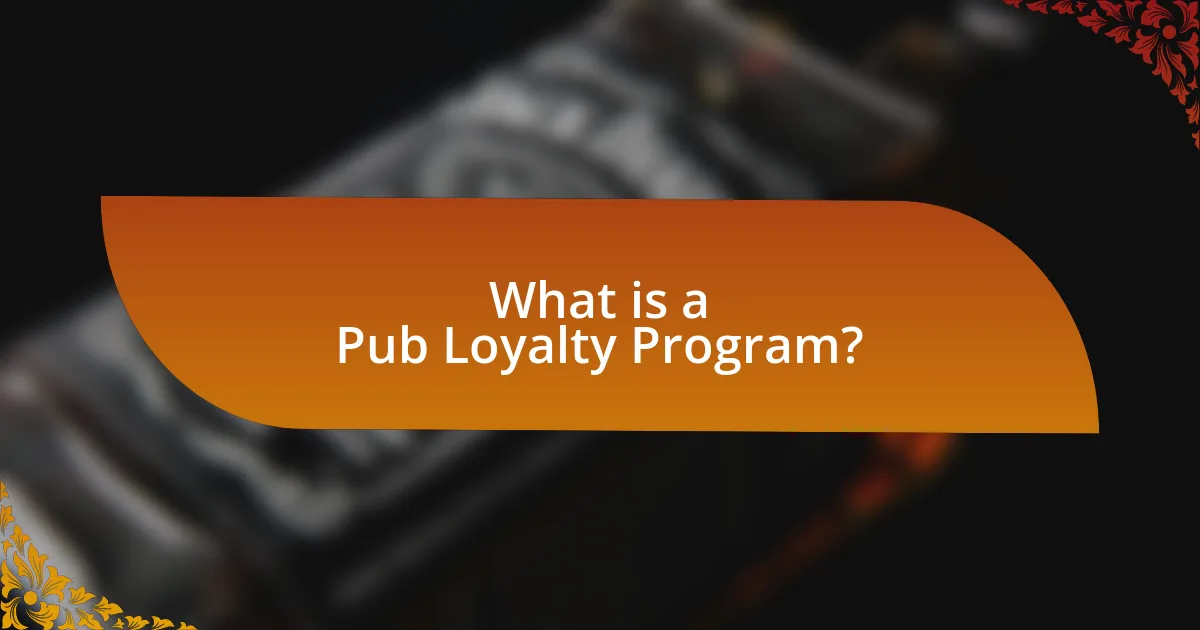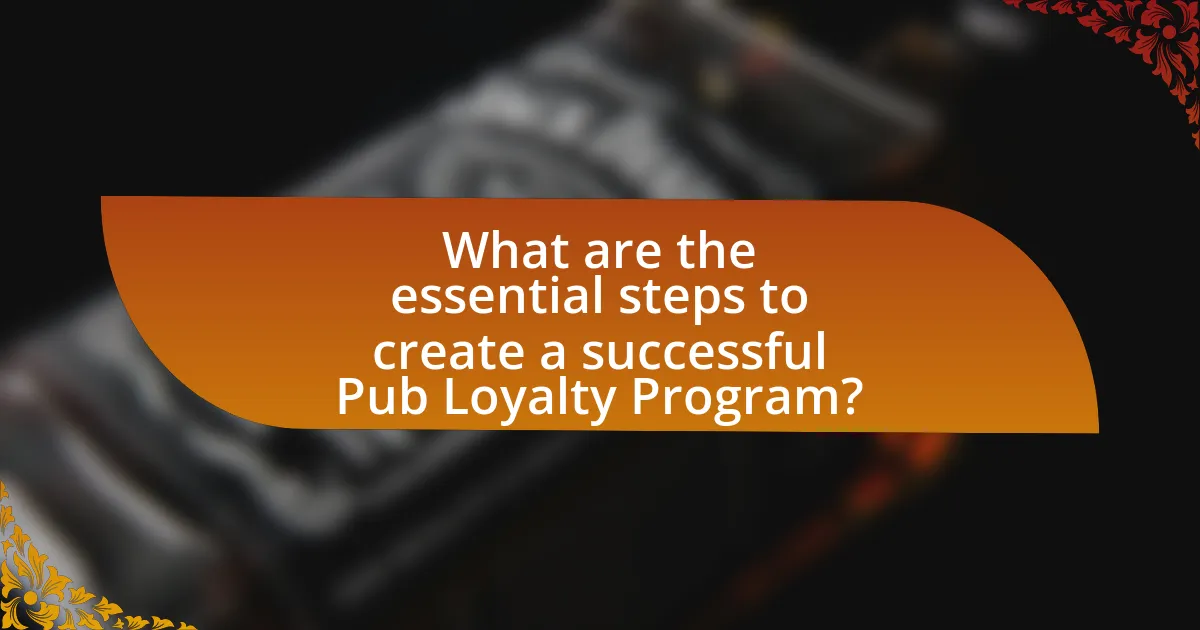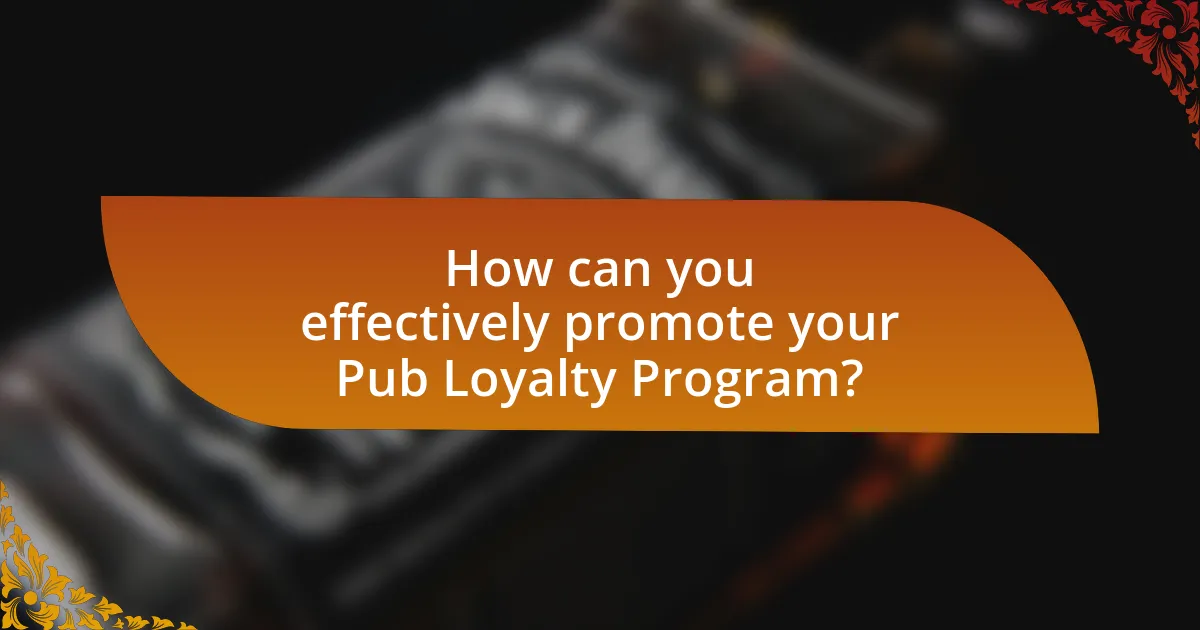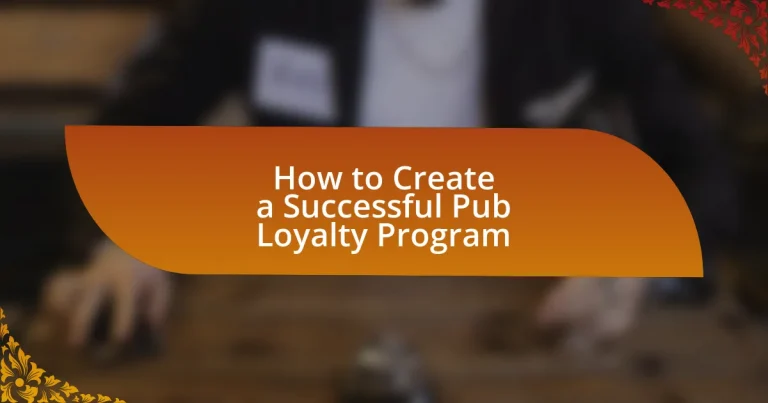A Pub Loyalty Program is a strategic marketing initiative aimed at fostering customer retention by rewarding patrons for their repeat business. This article outlines the essential components of an effective loyalty program, including the mechanics of rewards systems, customer engagement strategies, and data tracking methods. It emphasizes the importance of defining clear objectives, selecting appealing rewards, and promoting the program effectively to enhance visibility and participation. Additionally, the article discusses the impact of loyalty programs on customer retention rates and profitability, while providing best practices for maintaining a successful program and avoiding common pitfalls.

What is a Pub Loyalty Program?
A Pub Loyalty Program is a marketing strategy designed to encourage repeat business by rewarding customers for their patronage. These programs typically offer incentives such as discounts, free items, or exclusive access to events based on the frequency or amount of a customer’s purchases. Research indicates that businesses with loyalty programs can see a significant increase in customer retention rates, with studies showing that loyal customers are worth up to ten times as much as their first purchase.
How does a Pub Loyalty Program function?
A Pub Loyalty Program functions by rewarding customers for their repeat business, typically through a point system or membership benefits. Customers earn points for each purchase, which can later be redeemed for discounts, free items, or exclusive offers. This incentivizes frequent visits and enhances customer retention, as evidenced by studies showing that loyalty programs can increase customer spending by 20% to 30%.
What are the key components of a Pub Loyalty Program?
The key components of a Pub Loyalty Program include a rewards system, customer engagement strategies, and data tracking mechanisms. A rewards system incentivizes repeat visits by offering points or discounts for purchases, which encourages customer loyalty. Customer engagement strategies, such as personalized communication and exclusive events, enhance the relationship between the pub and its patrons, making them feel valued. Data tracking mechanisms allow the pub to analyze customer behavior and preferences, enabling tailored marketing efforts and improved service. These components collectively contribute to a successful loyalty program by fostering customer retention and increasing overall sales.
How do these components interact to enhance customer engagement?
The components of a successful pub loyalty program, such as rewards, personalized communication, and community events, interact synergistically to enhance customer engagement. Rewards incentivize repeat visits, while personalized communication fosters a sense of connection and recognition among patrons. Community events create shared experiences that strengthen customer relationships and loyalty. For instance, a study by the Loyalty Research Center found that personalized rewards can increase customer retention rates by up to 20%, demonstrating the effectiveness of these components working together to create a more engaging customer experience.
Why are Pub Loyalty Programs important for businesses?
Pub loyalty programs are important for businesses because they enhance customer retention and increase sales. By incentivizing repeat visits through rewards, pubs can foster a loyal customer base, which is crucial in a competitive market. Research indicates that acquiring a new customer can cost five times more than retaining an existing one, highlighting the financial benefits of loyalty programs. Additionally, a study by the Harvard Business Review found that increasing customer retention rates by just 5% can lead to an increase in profits of 25% to 95%. Thus, implementing effective loyalty programs not only strengthens customer relationships but also significantly boosts profitability for pubs.
What benefits do Pub Loyalty Programs provide to customers?
Pub Loyalty Programs provide customers with rewards such as discounts, exclusive offers, and personalized experiences that enhance their overall satisfaction and engagement. These programs incentivize repeat visits by allowing customers to accumulate points or rewards for their purchases, which can lead to free drinks, meals, or special promotions. Research indicates that loyalty programs can increase customer retention rates by up to 30%, demonstrating their effectiveness in fostering long-term relationships between pubs and patrons.
How do Pub Loyalty Programs impact customer retention rates?
Pub loyalty programs significantly enhance customer retention rates by incentivizing repeat visits through rewards and exclusive offers. Research indicates that establishments with loyalty programs can see a retention rate increase of up to 30%, as customers are more likely to return to earn rewards. Additionally, a study by the Harvard Business Review found that loyal customers are worth up to ten times their initial purchase, underscoring the financial benefits of retaining customers through loyalty initiatives. These programs create a sense of belonging and appreciation, further solidifying customer loyalty and encouraging ongoing patronage.

What are the essential steps to create a successful Pub Loyalty Program?
To create a successful Pub Loyalty Program, the essential steps include defining clear objectives, selecting an appealing rewards structure, implementing a user-friendly system, promoting the program effectively, and regularly evaluating its performance. Defining clear objectives helps establish what the program aims to achieve, such as increasing customer retention or boosting sales. Selecting an appealing rewards structure, such as points for purchases or exclusive discounts, incentivizes customer participation. Implementing a user-friendly system, whether through a mobile app or physical cards, ensures ease of use for customers. Promoting the program through various channels, including social media and in-house advertising, raises awareness and encourages sign-ups. Regularly evaluating performance through customer feedback and sales data allows for adjustments to enhance the program’s effectiveness. These steps are supported by industry studies showing that well-structured loyalty programs can increase customer retention rates by up to 30%.
How do you define the goals of your Pub Loyalty Program?
The goals of a Pub Loyalty Program are defined primarily to enhance customer retention, increase visit frequency, and boost overall sales. By implementing a structured rewards system, pubs can incentivize repeat visits, encouraging customers to choose their establishment over competitors. Research indicates that loyalty programs can increase customer retention rates by 5% to 10%, which can lead to a profit increase of 25% to 95% (Harvard Business Review, “The Loyalty Effect,” Kumar and Shah). This demonstrates that clearly defined goals focused on customer engagement and financial growth are essential for the success of a Pub Loyalty Program.
What metrics should you consider when setting goals?
When setting goals for a pub loyalty program, consider metrics such as customer retention rate, average transaction value, frequency of visits, and customer lifetime value. Customer retention rate measures the percentage of repeat customers, indicating the program’s effectiveness in fostering loyalty. Average transaction value reflects the revenue generated per visit, which can be influenced by loyalty incentives. Frequency of visits tracks how often customers return, providing insight into engagement levels. Customer lifetime value estimates the total revenue a customer generates over their relationship with the pub, helping to assess the long-term impact of the loyalty program. These metrics collectively provide a comprehensive view of the program’s success and areas for improvement.
How can you align your goals with customer expectations?
To align your goals with customer expectations, you must first understand customer needs through surveys and feedback mechanisms. This understanding allows you to tailor your loyalty program to meet those specific desires, such as offering rewards that resonate with your clientele. For instance, a study by the Loyalty Research Center found that 70% of consumers are more likely to engage with a brand that offers personalized rewards. By integrating this data into your program design, you ensure that your goals of increasing customer retention and satisfaction are directly aligned with what customers value most.
What types of rewards can be offered in a Pub Loyalty Program?
A Pub Loyalty Program can offer various types of rewards, including discounts on drinks, free food items, exclusive access to events, and points redeemable for merchandise. Discounts on drinks incentivize repeat visits, while free food items can encourage patrons to try new menu options. Exclusive access to events fosters a sense of community and belonging among loyal customers. Points systems allow customers to accumulate rewards over time, enhancing customer retention. These reward types are effective in increasing customer loyalty and driving sales in the pub industry.
How do different reward structures affect customer participation?
Different reward structures significantly influence customer participation by shaping their motivation to engage with loyalty programs. For instance, programs that offer immediate rewards, such as discounts or free items after a certain number of purchases, tend to increase participation rates because customers perceive instant gratification. Research by Kumar and Reinartz (2016) in “Creating Enduring Customer Value” indicates that immediate rewards can enhance customer satisfaction and encourage repeat visits. Conversely, reward structures that involve delayed gratification, such as points accumulation for future discounts, may lead to lower participation rates as customers might lose interest over time. A study published in the Journal of Marketing Research by Chandon et al. (2000) found that customers are more likely to participate in programs that provide clear and attainable rewards. Thus, the design of reward structures directly impacts customer engagement levels in loyalty programs.
What are the pros and cons of point-based versus tiered rewards?
Point-based rewards systems offer simplicity and immediate gratification, allowing customers to accumulate points for every purchase, which can be redeemed for rewards. This approach encourages frequent visits and spending, as customers can easily track their progress. However, the downside is that it may lead to lower perceived value if rewards are too easily attainable, potentially diminishing customer engagement over time.
In contrast, tiered rewards systems create a sense of exclusivity and motivation by offering different levels of rewards based on customer spending. This structure incentivizes customers to reach higher tiers for better rewards, fostering loyalty and increased spending. The drawback is that tiered systems can be complex, making it harder for customers to understand how to achieve higher tiers, which may discourage participation if the thresholds seem unattainable.
Overall, point-based systems are straightforward and encourage frequent engagement, while tiered systems promote long-term loyalty through a structured reward hierarchy.

How can you effectively promote your Pub Loyalty Program?
To effectively promote your Pub Loyalty Program, utilize a multi-channel marketing approach that includes social media, email campaigns, and in-house promotions. Social media platforms like Facebook and Instagram can showcase exclusive offers and customer testimonials, increasing visibility and engagement. Email campaigns can target existing customers with personalized messages about loyalty rewards, encouraging repeat visits. In-house promotions, such as signage and staff training, ensure that customers are informed about the program while they are on-site. According to a study by the National Restaurant Association, 70% of consumers are more likely to visit a restaurant that offers a loyalty program, highlighting the effectiveness of these promotional strategies.
What marketing strategies can enhance visibility for your program?
Implementing targeted social media advertising can significantly enhance visibility for your pub loyalty program. By utilizing platforms like Facebook and Instagram, pubs can reach specific demographics, increasing engagement and attracting potential customers. According to a study by Hootsuite, 73% of marketers believe that their efforts through social media marketing have been “somewhat effective” or “very effective” for their business, indicating the potential impact of these strategies. Additionally, leveraging local SEO techniques ensures that your program appears in search results when potential customers look for loyalty programs in your area, further boosting visibility.
How can social media be leveraged to attract new members?
Social media can be leveraged to attract new members by creating engaging content that highlights the benefits of joining a pub loyalty program. For instance, sharing testimonials from current members can build trust and showcase the value of the program. Additionally, targeted advertising on platforms like Facebook and Instagram can reach potential members based on their interests and demographics, increasing visibility. According to a study by Sprout Social, 70% of consumers are more likely to become loyal customers of brands they follow on social media, demonstrating the effectiveness of this approach in fostering community and engagement.
What role do in-house promotions play in program success?
In-house promotions are critical to the success of a pub loyalty program as they directly enhance customer engagement and retention. By offering exclusive deals, discounts, or rewards to loyalty program members, pubs can incentivize repeat visits and increase overall customer spending. Research indicates that businesses utilizing targeted promotions see a 20% increase in customer retention rates, demonstrating the effectiveness of in-house promotions in fostering loyalty. Additionally, these promotions create a sense of community and belonging among patrons, further solidifying their commitment to the establishment.
How can you gather feedback to improve your Pub Loyalty Program?
To gather feedback for improving your Pub Loyalty Program, implement surveys and direct customer interviews. Surveys can be distributed via email or in-person, allowing patrons to share their experiences and suggestions. Direct interviews provide deeper insights into customer preferences and pain points. According to a study by the American Marketing Association, businesses that actively seek customer feedback can increase customer satisfaction by up to 20%. This data supports the effectiveness of feedback mechanisms in enhancing loyalty programs.
What methods can be used to collect customer feedback?
Surveys, interviews, focus groups, feedback forms, and social media monitoring are effective methods to collect customer feedback. Surveys can be distributed online or in-person, allowing customers to provide their opinions on specific aspects of the pub experience. Interviews offer in-depth insights through direct conversations with customers. Focus groups facilitate discussions among a small group of customers, generating diverse perspectives. Feedback forms, often available at the point of sale or online, enable customers to share their thoughts easily. Social media monitoring allows businesses to track customer sentiments and comments in real-time, providing valuable insights into customer preferences and experiences. These methods are widely used in the hospitality industry to enhance customer satisfaction and loyalty.
How can feedback be utilized to refine program offerings?
Feedback can be utilized to refine program offerings by systematically collecting and analyzing customer insights to identify areas for improvement. For instance, surveys and focus groups can reveal customer preferences and pain points, allowing program managers to adjust features, rewards, or communication strategies accordingly. Research indicates that businesses that actively seek and implement customer feedback can see a 10-15% increase in customer satisfaction and retention rates, demonstrating the effectiveness of this approach in enhancing program offerings.
What are some best practices for maintaining a successful Pub Loyalty Program?
To maintain a successful Pub Loyalty Program, implement personalized rewards that cater to individual customer preferences. Personalization increases customer engagement; for instance, a study by Bond Brand Loyalty found that 79% of consumers are more likely to engage with brands that offer personalized experiences. Additionally, regularly communicate with members through emails or app notifications to keep them informed about exclusive offers and events, which fosters a sense of belonging and loyalty. Tracking customer behavior and preferences allows for tailored promotions, enhancing satisfaction and retention. Lastly, ensure that the program is easy to understand and use, as 70% of customers abandon loyalty programs due to complexity, according to a report by Accenture.
How often should you evaluate the effectiveness of your program?
You should evaluate the effectiveness of your program at least quarterly. Regular evaluations allow for timely adjustments based on customer feedback and engagement metrics. Research indicates that programs assessed every three months can adapt more effectively to changing consumer preferences, leading to a 20% increase in customer retention rates compared to annual evaluations. This frequency ensures that the program remains relevant and effective in achieving its goals.
What common pitfalls should be avoided in managing a loyalty program?
Common pitfalls to avoid in managing a loyalty program include lack of clear objectives, insufficient customer engagement, and overly complicated reward structures. Establishing clear objectives is crucial; without them, the program may fail to meet business goals or customer expectations. Insufficient customer engagement can lead to low participation rates, as customers may not feel incentivized to join or remain active in the program. Additionally, overly complicated reward structures can confuse customers, making it difficult for them to understand how to earn and redeem rewards, ultimately leading to frustration and disengagement. These pitfalls can significantly undermine the effectiveness of a loyalty program, as evidenced by studies showing that programs with clear, simple rewards see higher customer retention and satisfaction rates.


